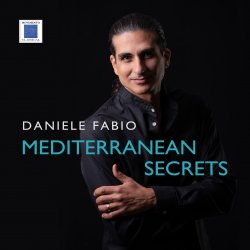

Duosfera
1 - Cape Horn
Inspired by the extraordinary sailing feat and the figure of Bernard Moitessier who in 1963 makes the first solo tour of the world in a sailing boat without stopover: the crossing Tahiti - Alicante via Capo Horn, a journey full of mystery, enthusiasm and mysticism.
2 – Memento
In our minds the present time is intertwined with our memory, with the impressions coming from the past, which project ambitions, fears and hopes towards what awaits us. So in every moment of our life, past, present and future coexist. A trio of guitars impersonates these three times, fused into one eternal real present.
3 - Fortuna Nova
This fantasy is inspired by the first two movements of Carmina Burana by Carl Orff. The text of "O Fortuna" tells of the mutability of desires and unpredictability of destiny, in relation to lunar influences, archetype of the unconscious. " Fortuna Nova" is an invitation to find within oneself the source of the will, capable of generating the destiny of our essence, whose archetype is the solar logos.
4 – Le notti di Orfeo
The piece is an inner evocation of the scenarios in the mind and heart of Orpheus, during his journey to rejoin Eurydice. In this path of the soul alternate hopes, fears, strength, despair, while love stands out above everything. The presence of electronics along with the guitar symbolizes the multidimensionality of the myth, which speaks in an allegorical key to the different levels of being.
5 – Smile
"Smile" is an elaboration inspired by the famous song written by Charlie Chaplin. The piece presents an atonal and dissonant introductory section that evokes the disharmonies of life, with its problems, conflicts, difficulties and inner dramas that every human being encounters. And it is precisely in those moments that the smile can make its way inside us, like a ray of light in the darkness, helping us to find the lost serenity.
“Smile tho' your heart is aching
Smile even tho' it's breaking
When there are clouds in the sky
You'll get by
If you smile
Thro' your fear and sorrow
Smile and maybe tomorrow
You'll see the sun come shin-ing thro' for you
if you just smile..."
6 – Juego
The classical guitar is imbued with the charm of Spain and the flamenco world. The literature of this instrument has often fed on the encounter between these two dimensions, the cultured one and the popular one, often evoking the borders of the Iberian peninsula. "Juego" is inspired by the rhythmic structure of the solea flamenca, one of the most famous compas in this tradition, inserted in the context of the Sonata Form, the main compositional structure of the classical period. Two worlds in one game.
7 – Scherzo Terzo
The "Three Jokes" constitute a collection that celebrates the union and juxtaposition of different languages, with freedom and without barriers, keeping the brilliant spirit typical of the compositional form of the joke. The Scherzo Terzo evokes cinema settings in which light and shadow create a chiaroscuro narrative.
8 - Scherzo Antico
In this baroque joke reminiscences meet rock drives, to give life to a radiant energy, which pulsates and dances on the strings of time.
9 – Asturias
The guitar version of the piano piece "Prelude- Leyenda" by Isaac Albeniz has become one of the iconic pieces related to the world of the six strings and this unprecedented arrangement for two guitars is a tribute.
10 – Carpets
Two guitars mix with electronics to create intertwined sound carpets in a kaleidoscopic dimension, through echoes of musical minimalism of the 70s, synths and vintage sounds.
11 – Insieme
A theme is exposed in continuous alternation between the two guitars, as if it were continuous dialogue between two friends who know how to talk and listen to each other. The song is a hymn to friendship, to the ability to build and evolve in synergy with others and is also a tribute to the master Ennio Morricone, in the year of his death.
12 - Libellule
The unique and characteristic flight of the dragonfly inspired this song. The continuous movement of the wings resonates in a light and constant arpeggio, enveloped by the warmth of the cello, to recall a summer scenario, period in which the dragonflies move more in their life cycle.
The sphere is union.
Inside there are no corners, no borders or barriers; each color blends into the other in a constantly changing design. The sphere is motionless and moving, it is full and empty,
Opposites meet in a timeless circular dance.
So is the music.
An act of love between sound and silence, a thin line that holds joy and weeping by the hand,
poignant remembrance of the past, heroic momentum towards the future, tension, courage, present life.
It paints on the canvas of the heart the impressions of the world, with colors made of emotion.
It is composed of the substance of which the universe is made,
resonates with the circular movements of the stars, travels and twirls,
to find a home in our soul.
In the soul it rests and becomes silence,
from the soul reborn to fly in the wind.
Music beats in the breast of every living being,
We are all part of the great orchestra of life, united in playing together the symphony of existence.
On the stage of the world everyone is both performer and audience
and the counterpoint of destiny intertwines our voices on the score of time.
Sometimes kindred spirits meet and their intentions align.
When this happens, the resulting energy is higher than the sum of the individual force.
This is how the Duosphere was born, a special, unexpected and surprising formation.
Two musicians united by the love for the search for the new and animated by the rediscovery of what was and continues to be. An inclusive music, which embraces without distinction of genre what resonates in time, puts it in its luggage and starts for a new journey.
Multiple languages alternate in the narration, the simplicity walks next to the complexity, the instrumental virtuosity enhances the compositional elaboration, alternating with an essential minimalism or an unscrupulous rebel vein that sometimes winks at the irony.
Everything merges into an evocative act, full of imagination. Known themes become the starting point for the emergence of new sound islands, original compositions come to life, inspired by deeds, legends, men, impressions, in a single sphere of communication that wants to speak to the hearts of people.
A music that comes from friendship, from life, from the courage to embark on unexplored paths, where the footsteps of our step are to trace the path.
Two guitars are the vessel of this adventure, twelve strings tell a story that has just begun to be written.

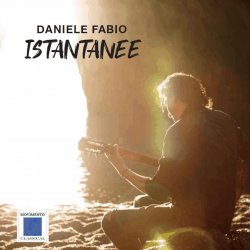
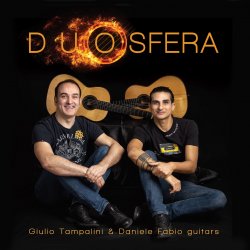
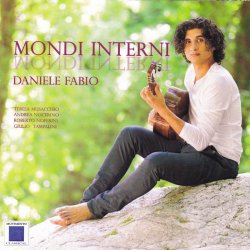
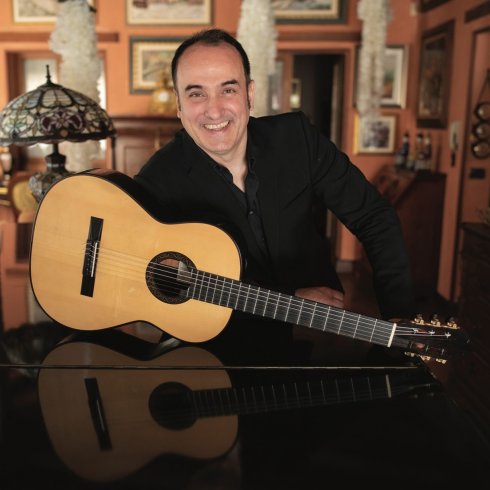
Giulio Tampalini
Giulio Tampalini has been hailed internationally as one of the most popular and charismatic classical guitarists, and as such he performs regularly and extensively in Italy and abroad. Winner of the Arts and Culture Prize (Milan, Italy 2014), he is a Warner Classics Artist, has recorded over 40 CDs and he has played more than 2000 concerts all over the world. He has won prizes at major international guitar competitions such as the “Narciso Yepes” Competition in Sanremo (chairman: Narciso Yepes); the International Rome Competition in 1996 and 2000; “De Bonis” International Competition in Cosenza; “Pittaluga” International Competition in Alessandria; “Fernando Sor” International Competiton in Rome and the “Andrés Segovia” International Competiton in Granada. His musical collaborations include the Soloists of the Teatro alla Scala in Milan. In 2003 his double CD “Francisco Tarrega: Complete Works for Guitar” was awarded the Golden Guitar at the International Guitar Meeting in Alessandria as “Best CD of the year”. Among his other CDs are: the “Concierto de Aranjuez” by Joaquin Rodrigo for guitar and orchestra, recorded with the Orchestra “Arturo Benedetti Michelangeli”; all the major guitar works by Angelo Gilardino; the complete Six Rossinianas by Mauro Giuliani; the Concerto no. 1 op. 99, the Quintet Op. 143 and the Romancero Gitano by Mario Castelnuovo-Tedesco, recorded with the Haydn Symphony Orchestra; the complete works for guitar by Miguel Llobet; and a DVD containing the complete solo guitar works by Heitor Villa-Lobos. Giulio Tampalini is a guitar professor at the Foundation International Academy in Imola and at the Adria State Conservatory of Music (Italy) and he is regularly invited to give masterclasses and concerts all over the world.
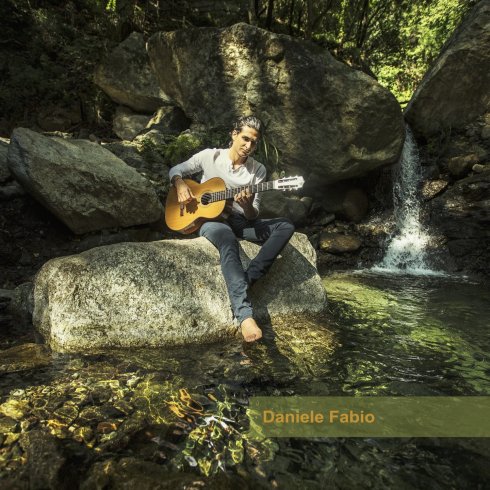
Daniele Fabio
He began his career path studying guitar and Jazz composition under the guidance of maestro Lutte Berg. He soon began to perform concert activity in jazz, rock and blues fields, alongside his study. He got in touch with the world of classical music studying Renaissance and Baroque lute at the Conservatory of Music of Cosenza under the guidance of Maestro Ugo Di Giovanni, collaborating with various baroque ensembles and orchestras such as the Ensemble of Ancient Music of the Conservatory of Cosenza and the Ensemble "Riflesso Armonico", performing “continuo” activity and with them a concert activity throughout Italy winning several international competitions in the sector. At the same time he deepens the study of ethnic music, voice, composition and arrangements, approaching the study of instruments such as the Arabic oud, the Irish bouzuki, percussions, the guitar-harp, ocarina and the recorder, mandolin, drums, bass, keyboards, fretless, classical, acoustic and electric guitar. He participates in various record productions as a musician, arranger, composer and singer, and performs an intense concert activity both as a session musician for artists between northern and southern Italy, such as Massimo Ferrante, Ennio Rega, and many others, both in formations directed by him. He collaborates with various theater companies, such as “Tolda 86”, dealing with composing and arranging music, performing in the main theaters of Calabria like Teatro Rendano, Teatro Morelli, the Piccolo di Castiglione, the Franz Teatro, and others.
At the same time he takes care of music teaching at various private institutes and academies in Calabria and Lombardia. Subsequently he studied Jazz at the civic school of Milan, and began a collaboration with Antonello Gabelli, with whom he constitutes the new official formation of “Corvi” as a singer, guitarist, composer and arranger, making several tours throughout Italy.
He continued his studies at the conservatory, in classical guitar and composition.
He formed several ensembles including ‘Aria’ with the opera singers Franco Ruggero Pino, Teresa Musacchio and Katia Mancuso on viol with whom he perform concerts in the main Calabrian theaters.
In the meantime he won several international competitions as a guitarist, and as a composer
